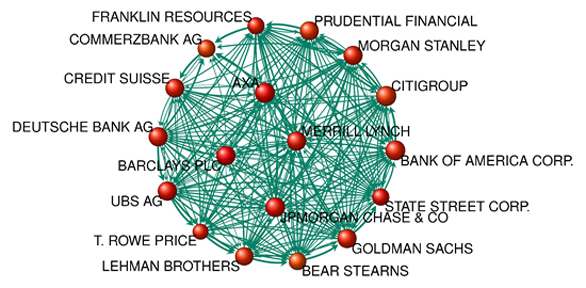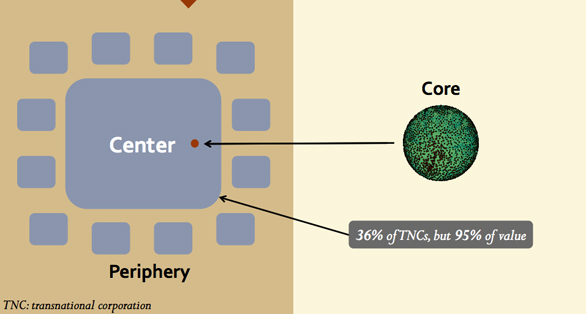Occupy Wall Street’s slogan “We are the 99%” had been echoing through the United States and the world for just over a month when James B. Glattfelder and his co-authors released the study “The Network of Global Corporate Control” in October 2011. The study was a scientific look at our global economy, revealing how control flows like water through pipes — some thin, some thick — between people and companies. The finding: that control of our economy is highly tightly concentrated into a small core of top players, leaving us all vulnerable to fast-spreading economic distress.
 James B. Glattfelder: Who controls the world?
James B. Glattfelder: Who controls the world?
In today’s talk, filmed at TEDxZurich, Glattfelder reveals that the impetus of the study wasn’t at all to validate global protesters. Instead, the study was conducted out of a desire to understand the laws that govern our economy, in the same way that we understand the laws that govern the physical world around us. Glattfelder and his co-authors Stefania Vitali and Stefano Battiston are complex systems theorists, meaning that they study a whole — for example, an ant colony or the human brain — as more than just the sum of its part. Complexity theory examines interactions between parts, looking for the simple rules that emerge when viewed en masse.
“Ideas relating to finance, economics and politics are very often tainted by people’s personal ideologies. I hope that this complexity perspective allows for some common ground to be found, “ Glattfelder says in today’s talk. “It would be great if it has the power to help end the gridlock of conflicting ideas, which appear to be paralyzing our global world. Reality is so complex — we need to move away from dogma. But this is only my personal ideology.”
To hear more about how the study was conducted, watch this talk. And to learn more about the results, and how they were received, keep reading.
To answer the question, “Who controls the world?” the study looked at ownership networks, breaking it down to nodes (such as firms, people, governments, foundations), links (the percentage of ownership) and value. Overall, the study looked at:
- 13 million ownership relations
- 43,000 transnational corporations
- 600,000 nodes
- 1 million links
At the top of this post is a 3D rendering of all the connections in this study. The dots represent the transnational corporations, nodes and links. Any section of it looks something like this.

As Glattfelder explains, in this ecosystem of transnational corporations, there is a periphery and there is a center — a connected network that contains about 75% of all the players. Nestled in this center is what the study calls the core. This core contains 1,300 highly connected nodes. While only 36% of transnational corporations are in this core, they make up 95% of the value of the entire network. This image will help to illustrate the core.

The authors of this study also assigned each player in this system a degree of influence. And overall, they found that the 737 top shareholders have the potential to control 80% of all the transnational corporations’ value. These top shareholders are mostly financial institutions in the US and UK. The first 10 on the list:
1. Barclays plc
2. Capital Group Companies Inc.
3. FMR Corporation
4. AXA
5. State Street Corporation
6. JP Morgan Chase & Co.
7. Legal & General Group plc
8. Vanguard Group Inc.
9. UBS AG
10. Merrill Lynch & Co Inc.
But their findings get even more extreme. The 146 top players in the core — representing just .024% of all the nodes studied — have the ability to control about 40% of transnational corporations’ value. This high degree of interconnectivity means that not only are we all highly influenced by a few — but that their distress is able to spread like wildfire.
The study, published in PLOS ONE at just the right time, quickly went viral. Read the study in its entirety »
Or check out some of the stories that ran about it:
- The New Scientist: Revealed — the capitalist network that runs the world (Oct. 24, 2011)
- The Montreal Review: Decoding Complexity (April 2012)
- Public Intelligence: Network of 147 companies control nearly 40% of global economic value of transnational corporations (Oct. 21, 2011)
- Science News: Financial world dominated by a few deep pockets (Sept. 24, 2011)
- Huffington Post: ‘Super-Entity’ of 147 companies at center of world’s economy, study claims (Oct. 24, 2011)
- Media Freedom International: Small network of corporations run the global Economy (April 4, 2012)
- Global Research: Bankers rule the world (Dec. 16, 2011)
As the story spread, Glattfeld and his co-authors took on the issue of whether their study was a proof of a conspiracy.
“Our study does NOT claim that the actors in the core are colluding. NOR does it claim that this structure is the result of some intentional design. We actually think that it probably emerges ‘naturally,’ as a result of simple mechanisms that are at work in the market,” they write here. “What we claim is that further studies are needed to investigate the implications of such a structure, because it is very well possible that it is [endangers] market competition and financial stability.”
Comments (32)
Pingback: Using physics to study the economy | outfind.ca
Pingback: Think Networks » Who controls the world? More resources for understanding
Pingback: Gospodarcza sieć | Takityle
Pingback: » Who controls the world? Resources for understanding this visualization of the global economy Non-Equilibrium Social Science
Pingback: Who controls the world? « Veritas delectat
Pingback: چه کسانی جهان را در اداره میکنند؟! یک تصویرسازی جالب از اقتصاد جهاناستایل شیت | استایل شیت
Pingback: چه کسانی جهان را در اداره میکنند؟! یک تصویرسازی جالب از اقتصاد جهان - مجله فناوری اطلاعات
Pingback: آنلاین تیتر چه کسانی جهان را در اداره میکنند؟! یک تصویرسازی جالب از اقتصاد جهان » آنلاین تیتر
Pingback: چه کسانی جهان را در اداره میکنند؟! یک تصویرسازی جالب از اقتصاد جهان | یک پزشک
Pingback: Global Power Elite? Yes. Masterminding Your Doom? Maybe not. | dissociatedpress.com
Pingback: TEDxZurich : Understanding Who controls the world? | AS-MAP
Pingback: Who controls the world? More resources for understanding | Joe Eigo Enlightened Warrior VORTEX
Pingback: Wizmo Blog » Blog Archive » Who controls the world? Resources for understanding this visualization of the global economy